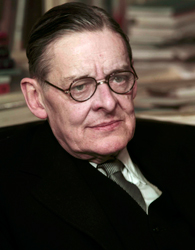As a philosopher, theologian, poet, playwright and essayist working in the early 20th century, T.S. Eliot saw and described the American and European landscape of both World War I and World War II. The writer of such unforgettable poems as “The Love Song of J. Alfred Prufrock,” “The Waste Land” and “The Four Quartets,” Eliot was awarded the Nobel Prize for Literature in 1948.
T.S. Eliot’s Early Days
Thomas Stearns Eliot was born on September 26, 1888, in St. Louis, Missouri. His father, Henry Ware Eliot, was president of the Hydraulic-Press Brick Company, and his mother, Charlotte Champe Stearns, was a former teacher, social worker and amateur poet.
Eliot was strongly encouraged to attend Harvard and during his studies of comparative literature there, Eliot fell in love with Arthur Symons’s “The Symbolist Movement in Literature” (1895), which inspired him to become a poet.
Eliot spent a postgraduate year in Paris, where he studied philosophy and wrote poetry. While in France, he decided to apply for a Philosophy Ph.D. from Harvard. Between 1911 and 1914, his studies included comparative methodology of science as well as Oriental religious philosophy. He returned to Europe in 1914 on scholarship to complete his thesis at Oxford.
Once in England, he split his time between attending university and visiting London, where he began to establish himself in various literary circles. A friendship with modernist poet Ezra Pound helped propel Eliot to literary success.
Sources in this Story
- University of Illinois at Urbana-Champaign (American National Biography): T.S. Eliot’s Life and Career
- The Literary Encyclopedia: T.S. Eliot
- Poets.org: T.S. Eliot
- Bartleby.com: T.S. Eliot
- Nobelprize.org: T.S. Eliot
- IMDb: Tom & Viv
- PBS: Broadway: The American Musical: Cats
Eliot’s Notable Accomplishments
When Ezra Pound was presented with Eliot’s early poems, including “The Love Song of J. Alfred Prufrock,” he immediately recognized the young writer’s potential and helped get Eliot published in several literary magazines.
Eliot’s poetry reflected themes of disillusionment, darkness and alienation, and was influenced both by 17th-century English metaphysical poets like John Donne, and 19th-century French symbolist poets like Charles Baudelaire.
Eliot wrote poetry, plays and critical essays. “Prufrock and Other Observations” was his first published collection. His famous poem, “The Waste Land,” details a soul’s search for redemption. “The Sacred Wood” is a collection of essays about poetry and criticism. These and other of Eliot’s works can be read on Bartleby.com.
Eliot won the Nobel Prize for Literature in 1948. When the prize was presented to him, Anders Österling, Permanent Secretary of the Swedish Academy, described Eliot’s work: “[I]t can never be denied that in his period he has been an eminent poser of questions, with a masterly gift for finding the apt wording, both in the language of poetry and in the defense of ideas in essay form.”
T.S. Eliot and his Work
- “The Waste Land and Other Writings”
- “Complete Poems and Plays: 1909–1950”
- “Old Possum’s Book of Practical Cats,” Illustrated Edition
- “Voices of the Poet: T.S. Eliot”
- “The Cambridge Companion to T.S. Eliot” edited by A. David Moody
The Rest of the Story
Although Eliot spent the majority of his life with Vivienne Haigh-Wood, whom he married in 1915, he separated from her in 1933. Her persistent emotional and mental instability made the marriage impossible to sustain. In 1938, Vivienne was committed to a mental hospital north of London. Their marriage is the subject of the 1994 film, “Tom and Viv.”
Eliot married Valerie Fletcher in 1956 and experienced the peaceful home life that had eluded him during his first marriage. During the later years of his life, Eliot worked as the director of Faber & Faber, a London publishing house. He continued to write on his own, but ceased writing poetry, focusing instead on plays and literary essays. He died in London on January 4, 1965.
Eliot’s poems have an honored position in academia, but his lighter work grabbed a foothold in popular culture in 1981, when composer Andrew Lloyd Weber adapted Eliot’s collection “Old Possum’s Book of Practical Cats” into the blockbuster musical “Cats.”
This article was originally written by Isabel Cowles; it was updated September 26, 2017.











